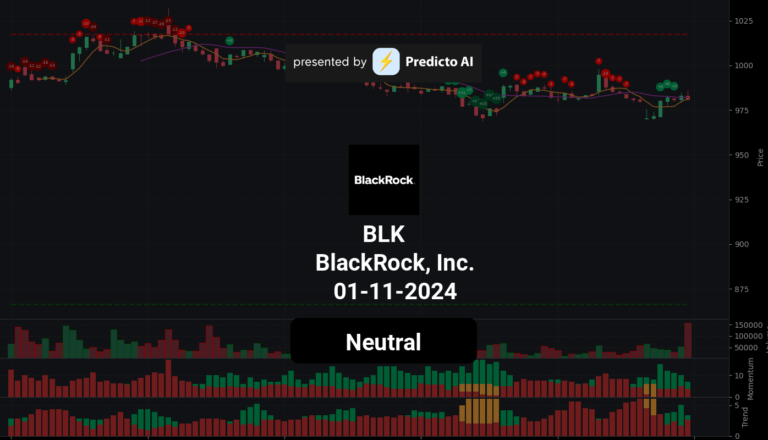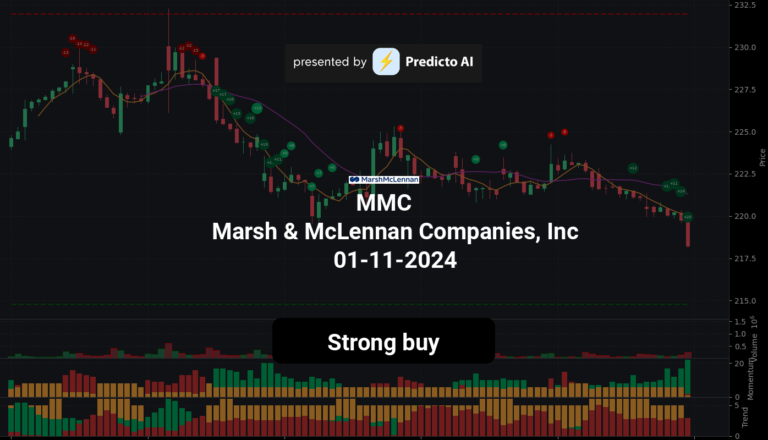UPS Stock Analysis: A Mixed Outlook Ahead!
🔴 Recommendation: UPS is currently rated a strong buy, but investors should proceed with caution due to conflicting indicators and market conditions.
📈 Key Highlights:
Positive Momentum Indicators: The stock shows several bullish signals, including a bullish divergence in On-Balance Volume (OBV) and the Money Flow Index (MFI), suggesting increasing buying pressure. Additionally, the Stochastic RSI is in oversold territory, indicating a potential price reversal.
Financial Health: Despite a net profit margin of 6.46% and a high debt-to-equity ratio of 2.44, UPS has a high institutional ownership of 72.30%, reflecting confidence from large investors.
⚠️ Caution Flags:
Bearish Trends: The stock is currently below the 50-day and 200-day Exponential Moving Averages (EMAs), indicating a strengthening bearish trend. Furthermore, recent downgrades from analysts, including Barclays, raise concerns about UPS’s competitive position against rivals like FedEx and Amazon.
Economic Environment: The increase in the unemployment rate to 4.3% and a slight decline in GDP growth suggest a potential slowdown in consumer demand, which could negatively impact UPS’s shipping volumes.
Let’s dive into the details as we break down the price trends, indicators, financial health, valuation metrics, and more 👇
UPS Price Analysis

| Positive Momentum Signals | Negative Momentum Signals | Hold Momentum Signals |
|---|---|---|
|
|
| Positive Trend Signals | Negative Trend Signals | Hold Trend Signals |
|---|---|---|
|
|
|
UPS stock currently presents a complex picture for investors. The stock is rated a strong buy, indicating a favorable outlook based on recent momentum indicators. Notably, there are several positive momentum indicators at play, including a bullish divergence in On-Balance Volume (OBV) and the Money Flow Index (MFI), both suggesting that buying pressure is increasing. Additionally, the Stochastic RSI is in oversold territory and shows a bullish divergence, which could signal a potential reversal in price trends. The WaveTrend indicator is also oversold, hinting at a possible bottom, while the Relative Strength Index (RSI) is moderately bullish.
However, despite these positive signals, there are significant negative trend indicators that investors should consider. The stock price is currently below the 50-day and 200-day Exponential Moving Averages (EMAs), indicating a bearish trend that is strengthening. Furthermore, the price is below the Supertrend indicator, which also suggests a bearish outlook. The price being below the middle band of the Bollinger Bands indicates that the stock is in a downtrend, although caution is advised due to the oversold conditions.
The MACD positive histogram crossover is a positive trend indicator, suggesting potential upward momentum, but it must be weighed against the bearish trends indicated by the EMAs and Supertrend.
In summary, while UPS stock shows several positive momentum indicators that could suggest a rebound, the prevailing bearish trends and the stock’s position relative to key moving averages warrant a cautious approach. Investors may consider a buy position, but should remain vigilant about the potential for further downside given the current market conditions.
UPS Fundamental Analysis
UPS’s recent financial performance presents a mixed picture, characterized by both positive and concerning indicators. The company’s net profit margin of 6.46% is relatively low, suggesting potential challenges in achieving robust profitability. Additionally, a debt-to-equity ratio of 2.44 raises significant concerns regarding financial risk and leverage, indicating that the company is heavily reliant on debt financing.
Liquidity issues are evident, as reflected in a current ratio of 0.47, which suggests that UPS may struggle to meet its short-term obligations. Furthermore, a cash to total assets ratio of 0.07 indicates limited financial flexibility, making the company vulnerable to economic downturns.
On the valuation front, the forward P/E ratio of 14.79 appears reasonable, suggesting that the stock may be fairly valued relative to its earnings. The price-to-sales ratio of 1.26 indicates a moderate valuation, but further analysis is necessary to assess the company’s growth potential.
In terms of growth and profitability, UPS has experienced a year-over-year revenue growth of only 0.52%, indicating only slight improvement in sales. More concerning is the earnings growth of -32.00%, which raises alarms about future profitability and operational efficiency. However, the company boasts an impressive operating margin of 100.00%, suggesting excellent operational efficiency, although this figure may require further context.
Shareholder information reveals a stable base, with an average ordinary shares outstanding of 854,403,335. The company has also engaged in stock repurchases totaling $1.62 billion, which can be a positive signal for investors, potentially boosting earnings per share.
Analyzing the income statement, UPS reported a net income of $1.41 billion, indicating profitability despite the challenges faced. However, total revenue of $21.82 billion shows only slight growth, which may not be sufficient to attract investors. Additionally, a net interest income of -$212 million suggests that the company is paying more in interest than it earns, which could further impact profitability.
The balance sheet reveals an average net debt of $16.61 billion, warranting further investigation into its impact on financial flexibility. The average total debt of $25.63 billion indicates significant leverage, posing risks in a downturn. The average tangible book value of $10.50 billion reflects the company’s net worth, but a more comprehensive analysis is needed for a complete picture.
In terms of cash flow, UPS shows promise with an average capital expenditures of $4.88 billion, indicating investment in growth and expansion. Additionally, net cash from financing of $4.83 billion suggests that the company is raising capital, potentially for growth or debt reduction. However, a free cash flow of $1.87 billion is positive but should be monitored for sustainability.
Overall, while UPS exhibits some positive indicators, the high debt levels and low profitability margins raise significant concerns. The company may face challenges in maintaining growth and managing financial risks. Investors should approach UPS with caution, carefully evaluating its ability to navigate these challenges before making any investment decisions.
Financial Health
🔴 Net Profit Margin of 6.46% is relatively low, indicating potential challenges in profitability.
🔴 Debt-to-Equity Ratio of 2.44 is high, raising concerns about financial risk and leverage.
🔴 Current Ratio of 0.47 suggests liquidity issues, as the company may struggle to meet short-term obligations.
🔴 Cash to Total Assets Ratio of 0.07 indicates limited financial flexibility, making the company vulnerable to economic downturns.
Valuation
🟡 Forward P/E Ratio of 14.79 is reasonable, suggesting the stock may be fairly valued relative to earnings.
🟡 Price-to-Sales Ratio of 1.26 indicates a moderate valuation, but further analysis is needed to assess growth potential.
Growth and Profitability
🔴 Year-over-year revenue growth of 0.52% is modest, indicating only slight improvement in sales.
🔴 Earnings Growth of -32.00% raises concerns about future profitability and operational efficiency.
🟢 Operating Margin of 100.00% suggests excellent operational efficiency, although this figure may need further context.
Shareholder Information
🟡 Average Ordinary Shares Outstanding at 854,403,335 indicates a stable shareholder base, but fluctuations could impact stock price.
🟢 Stock Repurchases of $1.62 billion can be a positive signal, potentially boosting earnings per share.
Income Statement
🟢 Net Income for the most recent period was $1.41 billion, indicating profitability despite challenges.
🔴 Total Revenue of $21.82 billion shows only slight growth, which may not be sufficient to attract investors.
🔴 Net Interest Income of -$212 million suggests the company is paying more in interest than it earns, which could impact profitability.
Balance Sheet
🔴 Average Net Debt of $16.61 billion warrants further investigation into its impact on financial flexibility.
🔴 Average Total Debt of $25.63 billion indicates significant leverage, which could pose risks in a downturn.
🟡 Average Tangible Book Value of $10.50 billion reflects the company’s net worth, but further analysis is needed for a complete picture.
Cashflow
🟢 Average Capital Expenditures of $4.88 billion suggest investment in growth and expansion, which is a positive sign.
🟢 Net Cash from Financing of $4.83 billion indicates the company is raising capital, potentially for growth or debt reduction.
🔴 Free Cash Flow of $1.87 billion is positive but should be monitored for sustainability.
Overall, while UPS shows some positive indicators, the high debt levels and low profitability margins raise concerns. The company may face challenges in maintaining growth and managing financial risks.
UPS News Analysis
UPS faces significant challenges from increased competition and downgrades, indicating a bearish outlook for investors.
Summary of UPS news indicates a troubling trend for United Parcel Service, Inc. (UPS). The stock has been under pressure due to competitive threats from FedEx and Amazon, leading to downgrades from analysts. This situation is compounded by the company’s poor performance relative to other blue-chip stocks. Investors should be cautious as the outlook appears negative.
🔴 UPS stock is down today, primarily due to increased competition and negative analyst sentiment.
🔴 Barclays has downgraded UPS, citing rising competition from FedEx and Amazon, which could impact market share and profitability.
🔴 A report highlights UPS as one of the worst-performing blue-chip stocks in 2024, raising concerns about its long-term viability.
🔴 Analysts have issued rare sell calls on UPS, indicating a lack of confidence in its ability to compete effectively in the current market landscape.
🔴 The upcoming Q3 earnings preview suggests that investors should be wary, as expectations may not meet the headline estimates.
🔴 Overall, the sentiment surrounding UPS is increasingly negative, with multiple sources indicating a challenging environment ahead.
UPS Holders Analysis
The financial landscape for UPS presents a mixed outlook, leading to a neutral recommendation for the stock over the next month. While there are positive aspects, there are also notable concerns that warrant caution.
🟢 UPS has a **high institutional ownership** at **72.30%**, indicating strong interest from large investors, which often reflects confidence in the company’s long-term prospects. This level of institutional backing can provide stability to the stock price.
🟡 However, the **insider ownership is very low at 0.01%**, suggesting a lack of confidence from company management. This could indicate that insiders do not see significant upside potential in the stock, which is a red flag for potential investors.
🟡 The number of institutional holders is substantial at **2705**, which indicates a diversified ownership structure. This can help mitigate volatility, but it also means that if a significant number of these institutions decide to sell, it could lead to increased price fluctuations.
🔴 Recent insider transactions show a **predominance of sales** rather than purchases, which could signal a lack of confidence in the company’s near-term performance. This trend is concerning, as it may indicate that insiders are not optimistic about the stock’s future.
🔴 The overall market conditions and economic factors, such as inflation and supply chain issues, could impact UPS’s performance in the coming month. These external pressures may lead to volatility in the stock price.
In summary, while UPS has strong institutional backing, the low insider ownership and recent selling activity raise concerns. Therefore, a neutral stance is recommended for the next month, with the potential for volatility based on broader market conditions.
UPS Analyst Ratings
The analyst ratings for UPS show a mixed sentiment, with a notable number of hold ratings dominating the recommendations. Recent downgrades, such as Barclays moving from Underweight to Equal-Weight, indicate some caution among analysts.
🟡 In the past month, there have been 4 strong buy ratings, 2 buy ratings, 19 hold ratings, 1 sell rating, and no strong sell ratings. This distribution suggests that while there are some bullish sentiments, the majority of analysts are adopting a wait-and-see approach.
🔴 The recent downgrade from Barclays and the lack of strong buy recommendations may reflect concerns about UPS’s growth prospects in the current economic environment.
Given the mixed analyst sentiment and the recent downgrade, it is likely that UPS will experience limited movement in the next month, with a forecasted price range of approximately $150 to $160. The medium confidence level indicates that while there are some positive indicators, caution is warranted due to the prevailing hold ratings.
UPS Economic Analysis
Based on the US economic and market data:
🔴 The unemployment rate has increased to 4.3%, up from 4.1% in the previous month, indicating a potential slowdown in the labor market which could negatively impact consumer spending and, consequently, UPS’s shipping volumes.
🟡 Retail sales have shown a slight increase, but the growth is modest at 2.5% month-over-month, suggesting that consumer demand is stable but not robust enough to drive significant growth for logistics companies like UPS.
🔴 The recent decline in GDP growth to 5737.189 billion USD from 5761.525 billion USD indicates a potential contraction in economic activity, which could lead to reduced shipping needs.
🟢 The monthly Treasury yield has stabilized around 4.25%, which is favorable for corporate borrowing costs, potentially allowing UPS to invest in growth initiatives.
🔴 The overall market sentiment appears cautious, with major indices like the S&P 500 and NASDAQ showing volatility, which may lead to investor hesitance regarding UPS stock.
In summary, while there are some positive indicators, the overall economic environment suggests caution. The increase in unemployment and slight GDP decline could lead to lower demand for UPS’s services in the coming month. Therefore, I would recommend a neutral stance on UPS stock for the next month, with a price target range of 130 to 135 USD based on current market conditions.
Disclaimer
Investors may consider the AI predictions and news summaries as one factor in their investment decisions alongside their own research and risk tolerance.




